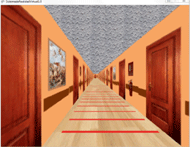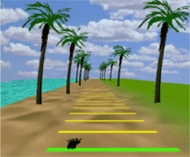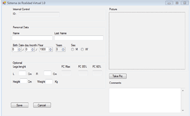VR Treadmill System for Gait Research and Rehabilitation of Patients with Parkinson`s Disease.
Arturo Gonzalez-Mendozaa, Alberto Isaac Perez-Sanpablo MSca, Ivett Quiñones-Urióstegui MSca, Lidia Nuñez-Carrera BSa, Aldo Alessi-Montero BSa,
Gerardo Rodriguez-Reyes MSca, Claudia Hernandez-Arenas MDb.
a Human Movement Analysis Lab,National Institute of Rehabilitation, INR, Mexico City, Mex;
bNeuro- rehabilitation Department, National Institute of Rehabilitation, INR, Mexico City, Mex;
ABSTRACT
Virtual Reality (VR) in Neurorehabilitation allows reduce patients risk and allows them to learn faster. Up to now VR has been used in patients with Parkinson disease as a research tool and none of the developed systems are used in clinical practice. The goal of this project is to archive a VR system for gait therapy, and research of patients with PD based on published evidence. The system uses a digital camera to measure spatiotemporal gait parameters. The software is developed in C#, using OpenSource libraries that facilitate VR programming. The developed system has potential uses in clinical and research settings.
KEYWORDS
Virtual reality; VR; Virtual environments; Parkinson ́s Disease; PD; cueing; treadmill.
BACKGROUND
VR has been used in Neurorehabilitation field provide interfaces where patients can interact within virtual worlds that simulates real worlds. VR allows a high level of control of the interaction and the experience provided to the patient within the virtual world [1]. This lets health care professionals to make tasks easier, reduce patient’s risk, improve patient’s attachment to treatment by making it more entertaining, provide controlled stimuli to patient, measure patient response, and finally to optimize effect of therapy by individualization based on patient condition and progress. This results on several advantages of VR-based therapies over traditional procedures [2].
Motivated also by advantages of technology and reduction of costs, during the last years more VR-based therapies have appeared, some of them based on overexcitement and unrealistic expectations by developers and health care professionals [1].
Evidence about the efficacy of VR-based therapies should be analyzed carefully. The best assessment of the efficacy of a therapy is found on systematic reviews and randomized, controlled clinical trials (RCT). However, up to now there are neither systematic reviews nor RCT ́s about efficacy of VR-based therapies for Gait rehabilitation of patients with Parkinson’s disease (PD).
VR has been used in PD patients to study cognitive deficits [3], [4], sleep dysfunctions [5], perception dysfunctions [6], [7], motor learning [8], [9], postural control [10], [11] and gait [2], [12], however the only RCT published studies the effect of a VR-based therapy on postural control [11] and not on gait.
Patients with PD suffer from a progressive disabling disorder, which is mainly due to the involvement of the basal ganglia [13]. Characteristic symptoms of the disease are tremor, rigidity, and postural instability, loss of speed or limited range of movement (hypokinesia) and inability to perform voluntary movements (akinesia) [14].
Most of the previous VR-based systems developed to study PD dysfunctions are research systems and none of them have reached the application stage during clinical practice [1], [2]. One reason is that systems are too complex and expensive for common clinical practice due to its high flexibility. Flexibility allows them to be used to study a wide range of neurological conditions; however in real clinical practice such a system can be sub used. The design of those systems should be based both on a human centered approach and on the best published evidence [1].
OBJECTIVE
This projects aims to develop a VR system for gait research and rehabilitation of Patients with PD considering human centered issues and previous published data in order to accelerate the process of solving clinical and research questions. The system aims to measure gait velocity, cadence, step length and STV parameters through image processing techniques in real time returning auditory and visual stimuli feedback that allows control over walking speed, cadence and step length for a better rehabilitation.
METHODOLOGY
Design philosophy
Philosophy of design was based on Evidence-Based Medicine and on Human centered design for interactive systems like the standard ISO 9241-210:2009 [16]. Therefore a clear understanding of tasks was needed: context of use, user requirements, organization requirements, and appropriate allocation of function.
Consequently, the present system is meant to be used in gait research and therapy as a supplement to conventional pharmacological treatment of ambulatory PD patients within a high specialty public hospital such as the Mexican National Institute of Rehabilitation (INR).
Design Characteristics
Design was focused in average PD subject characteristics: average height of 160 cm with normal binocular horizontal field of view of 120°, full below eye level field of view of 70°, Hoehn & Yahr score from 1 to 3, able to walk over a treadmill with a walking speed range between 1.3 – 3.9 km/h, maximum cadence of 2.22 steps per second according to published results [13].
System must allow control over walking speed, cadence and step length by means of treadmill, auditory and visual stimuli (VS) respectively and also must allow to measure gait velocity, cadence, and step length parameters. VS are transverse lines placed over the floor with 50 cm length, 5 cm width and separated by a distance equal to the ideal step length for the subject based on his height and age. Auditory stimulus consisting of high frequency beats of 40 ms delivered at the same frequency of subject’s cadence. These design characteristics were identified previously by literature search and expert consultation [15].
Hardware and Spatial Configuration of the System
Treadmill speed range fulfills average PD subject walking speed range mentioned above.
The camera is placed to the side of the treadmill. Previously mentioned VS are delivered through a virtual environment. To display the virtual environment the system will use three screen displays, the first screen display haves a size of 3.50 x 2.60 m and goes in the middle of the other two screens that will have a size of 2.60 X 2.60 m. Screens guarantee complete subject ́s immersion in the virtual environment [15]
The virtual environment is displayed with three short throw projectors with a throw distance value of 0.6 m, and a display update of 60 Hz (Benq MX810ST). The Projectors are positioned to a distance around 160 cm away from the screens at a height of 273 cm.
 Figure 1: Rectangular calibration grid. d
Figure 1: Rectangular calibration grid. dGait velocity, cadence, and step length parameters are measured by image processing techniques in real time using a camera with a sampling rate at least of 30 frames per second (fps). This characteristic is essential to guarantee the step detection with an error less than 10 percent when PD subject is walking at 2.22 steps per second. Theoretically maximum time error in step detection could be 33 ms[15].
 Figure 2: The left image shows the conceptual view of the spatial configuration; the right image is the constructed prototype. d
Figure 2: The left image shows the conceptual view of the spatial configuration; the right image is the constructed prototype. dSubject’s feet are detected using two color markers. Each foot has a different color. In order to obtain markers spatial coordinates camera calibration is performed using a rectangular grid (Fig. 1).
Safety issues are solved using a partial weight support, previously designed at the INR for avoiding the camera occlusion. The main concept and the constructed prototype of the spatial configuration of the system are shown in Fig 2.
System is controlled by a computer with a Intel core i7 processor, 8Gb Ram memory, and a AMD RAEDON HD 6770 1Gb graphic card, that supports up to three monitors and real time rendering.
Software and signal processing
The system software is programmed in the language C# in Windows 7. The C# language was chosen as programming language because it has the necessary libraries to control low-level hardware such as webcams, and graphic cards for the development of virtual environments, and also has a free set of tools that facilitates the game programming called Microsoft XNA (Microsoft, Redmond, WA, USA). The system software displays the virtual environment, and also deploys the visual and auditory stimuli; such stimuli are displayed depending on the detection of events like heel strike and speed.
To ensure a good performance of the system, the programming use threads. There are three main actions that run in threads: image acquisition and marker detection, calculation of walking parameters (heel strike, speed, cadence and STV), and the principal thread which is VR interface.
Image acquisition and image processing are being made using the “touchless” library (Microsoft, Redmond, WA, USA), which is an open source library; this allows the video flow stream and the detection of color markers. Markers are detected and segmented in HSL color space.
Gait velocity, cadence, and step length parameters are calculated based on identification of gait events like heel strike and toe off.
Gait events are detected based on local minima and maxima of feet coordinates: local minimum coordinates along time indicate heel strike i.e. Cadence is calculated as the number of heel strikes within a minute. Step length is calculated as the spatial difference between the local minimum of first foot and the next maximum of contralateral foot. Walking speed in meters per second is calculated every minute using both feet average step length in centimeters (SL) and number of steps (NS) as shown in equation 1.
walking speed = (SL * NS * 60)/100,000 (1)
Once acquired these parameters the software is ready to send the visual and auditory stimuli to the patient through the VR interface.
Virtual environment
 Figure 3: Indoor Virtual Environment d
Figure 3: Indoor Virtual Environment dThe virtual environments (VE) are developed in Softimage, this program developed by Autodesk is free license for non-commercial projects, and facilitates the development models in 3D and the integration to the library for games in XNA. The system haves three types of VE, the first one will simulate an indoor therapy which is a hall way with doors (Fig 3), and the second and third environment will simulate the outdoor training these environments are a beach and a forest (Fig 4) respectively.
 Figure 4: Outdoor environments. Figure a) Beach Virtual Environment. Figure b) Forest Virtual Environment. d
Figure 4: Outdoor environments. Figure a) Beach Virtual Environment. Figure b) Forest Virtual Environment. dThe system will display the three VE in an infinite hallway that is made thought the duplication of finite hallways.
System Feedback
As mentioned above the auditory feedback are 40 ms beats with a frequency of 1500 kHz, the auditory stimulus is controlled by a timer event that is triggered every time user meets cadence time specified at the beginning of the program.
 Figure 5: Visual stimulus showing the current line highlighted of green color with a feedback footprint above the line meaning that the last step was larger than the required step. d
Figure 5: Visual stimulus showing the current line highlighted of green color with a feedback footprint above the line meaning that the last step was larger than the required step. dThe visual stimulus consists of two elements, which are green highlighting of the current line and deployment of a footprint which shows the length of the previous step, if the last step length was larger than the required step length the footprint will be deployed further the green line. If last step length was shorter than required step length, footprint will be displayed before the green line, a clear example shown in Fig 5.
System Database
 Figure 6: Database entry form of a new patient. d
Figure 6: Database entry form of a new patient. dThe database is an internal control that handles patients list and studies list. Information is stored in an excel spreadsheet to facilitate data management. The patient list keeps information such as name, last name, date of birth, and age for proper identification of the patient. Further optional data as the length of the legs, height, age and maximal heart rate can be saved for better data analysis. Also a patient’s picture and relevant comments can be saved optionally. The form to add a new patient is shown in Fig. 6.
The data stored in each study is the number of study, patient identification number, date of study, step lengths and a video from the study.
Results
 Figure 7: On the left of the program window is the subject testing, on the left is shown the footsteps detection. d
Figure 7: On the left of the program window is the subject testing, on the left is shown the footsteps detection. dIn order to calculate system error three tests with three subjects were performed. These tests were as follows: subject walking at 1.5 km / h, 2.5 km / h, and 3.5 km / h.
These speeds were chosen because of the velocity range of PD subjects. Once obtained these data was compared with the treadmill Biodex II and the results were the following: mean square error of 6.05 cm and a mean [7] percentage error of 9.3 (Fig 7).
DISCUSSION
Major source of error are camera calibration and marker detection. In order to reduce errors due to camera calibration, use of grid large enough to cover system working space is required. Smaller grids result on errors that could be emphasized due to optics of the camera. Marker detection is improved by avoiding presence within the system working space of objects with similar color to those detected. Therefore controlling the environment results on a more robust system.
However developed system promises to be a good system for clinical use and research because of its design considers human centered issues and is based on best available knowledge.
REFERENCES
- G. Riva, "Applications of virtual environments in medicine," Methods Inf Med, vol. 42, pp. 524-34, 2003.
- M. K. Holden, "Virtual environments for motor rehabilitation: review," Cyberpsychol Behav, vol. 8, pp. 187-211; discussion 212-9, Jun 2005.
- G. Albani, S. Raspelli, L. Carelli, F. Morganti, P. L. Weiss, R. Kizony, N. Katz, A. Mauro, and G. Riva, "Executive functions in a virtual world: a study in Parkinson's disease," Stud Health Technol Inform, vol. 154, pp. 92-6.
- E. Klinger, I. Chemin, S. Lebreton, and R. M. Marie, "Virtual action planning in Parkinson's disease: a control study," Cyberpsychol Behav, vol. 9, pp. 342-7, Jun 2006.
- G. Albani, S. Raspelli, L. Carelli, L. Priano, R. Pignatti, F. Morganti, A. Gaggioli, P. L. Weiss, R. Kizony, N. Katz, A. Mauro, and G. Riva, "Sleep dysfunctions influence decision making in undemented Parkinson's disease patients: a study in a virtual supermarket," Stud Health Technol Inform, vol. 163, pp. 8-10.
- S. Davidsdottir, R. Wagenaar, D. Young, and A. Cronin- Golomb, "Impact of optic flow perception and egocentric coordinates on veering in Parkinson's disease," Brain, vol. 131, pp. 2882-93, Nov 2008.
- M. Onofrj, L. Bonanni, G. Albani, A. Mauro, D. Bulla, and A. Thomas, "Visual hallucinations in Parkinson's disease: clues to separate origins," J Neurol Sci, vol. 248, pp. 143-50, Oct 25 2006.
- J. Messier, S. Adamovich, D. Jack, W. Hening, J. Sage, and H. Poizner, "Visuomotor learning in immersive 3D virtual reality in Parkinson's disease and in aging," Exp Brain Res, vol. 179, pp. 457-74, May 2007.
- D. J. Myall, M. R. MacAskill, P. R. Davidson, T. J. Anderson, and R. D. Jones, "Design of a modular and low-latency virtual- environment platform for applications in motor adaptation research, neurological disorders, and neurorehabilitation," IEEE Trans Neural Syst Rehabil Eng, vol. 16, pp. 298-309, Jun 2008.
- H. Suarez, D. Geisinger, A. Suarez, X. Carrera, R. Buzo, and I. Amorin, "Postural control and sensory perception in patients with Parkinson's disease," Acta Otolaryngol, vol. 129, pp. 354- 60, Apr 2009.
- C.Y.Yen,K.H.Lin,M.H.Hu,R.M.Wu,T.W.Lu,andC.H. Lin, "Effects of virtual reality-augmented balance training on sensory organization and attentional demand for postural control in people with Parkinson disease: a randomized controlled trial," Phys Ther, vol. 91, pp. 862-74, Jun.
- A. Mirelman, I. Maidan, T. Herman, J. E. Deutsch, N. Giladi, and J. M. Hausdorff, "Virtual reality for gait training: can it induce motor learning to enhance complex walking and reduce fall risk in patients with Parkinson's disease?," J Gerontol A Biol Sci Med Sci, vol. 66, pp. 234-40, Feb.
- J. Mehrholz, R. Friis, J. Kugler, S. Twork, A. Storch, and M. Pohl, "Treadmill training for patients with Parkinson's disease," Cochrane Database Syst Rev, p. CD007830.
- J. Jankovic, "Parkinson's disease: clinical features and diagnosis," J Neurol Neurosurg Psychiatry, vol. 79, pp. 368-76, Apr 2008.
- A. I. Perez-Sanpablo, et all (2011). Evidence-Based Design of a VR-based Treadmill System for Gait Research and Rehabilitation of Patients with Parkinson`s Disease. Proceedings of the UCAmI 5th Annual Conference. Riviera Maya, Mex.
- W. C. R. R. E. Fellin, T. D. Royer, I. S. Davis, "Comparison of methods for Kinematic identification of footstrike and toeoff during overground and tradmill running," Journal of Science and Medicine in Sport vol. 13, pp. 646-650, 2010.
ACKNOWLEDGMENT
This research is supported by the Mexican National Council of Science and Technology CONACyT (protocol number 2010-01-139718)